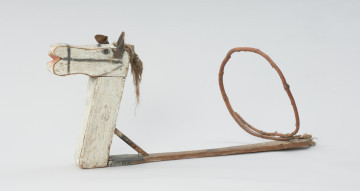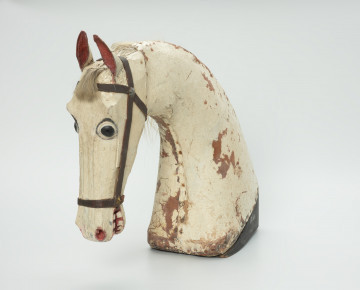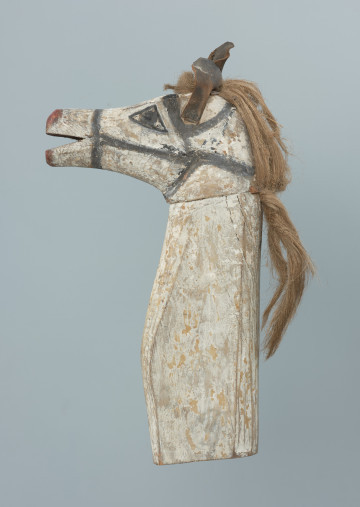
Hoarse - ceremonial item
1. połowa XX wieku
National Museum in Szczecin
Part of the collection: Material culture of West Pomerania
Even in the first half of the 20th century, carol singing groups could be seen wandering from house to house in Pomeranian villages during the Christmas and carnival season. The carol singers wished the residents good luck and performed ritual scenes. This custom was very old, and its origins can be traced back to Slavic beliefs. Apart from human characters, the cheerful and noisy parades also featured animal creatures and each of them had an assigned symbolic meaning. One of them was a stork, a relatively rare member of carol groups. The boy who would play the stork was dressed in a white sheet and held a long stick in his hand, topped with a bird head made of wood, with a distinctive, clattering beak. The stork played a vital role in folk beliefs. It was associated with marriage, motherhood, fertility and care. The arrival of the stork signalled the imminent arrival of spring and the rebirth of nature after the winter slumber. Its presence on the farm augured good luck for the inhabitants, and the people used to predict weather from its behaviour. In the collection of the Department of Ethnography of Pomerania of the National Museum in Szczecin, there is one ceremonial stork costume. The bird's head is realistically sculpted, with a long, red-painted beak that was moved by a string attached to it. The stork comes from the first half of the 20th century. Before the Second World War, it was in the collection of the Pommersches Landesmuseum Stettin.
Agnieszka Słowińska
Author / creator
Dimensions
cały obiekt: height: 8 cm, width: 42,5 cm
Creation time / dating
Creation / finding place
Identification number
Location / status

1. połowa XX wieku
National Museum in Szczecin

1. połowa XX wieku
National Museum in Szczecin

National Museum in Szczecin
DISCOVER this TOPIC
Museum of King Jan III's Palace at Wilanów
DISCOVER this PATH
Educational path